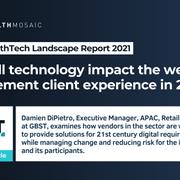In recent years, there has been a lot of talk about the potential of the Internet of Things (IoT) to revolutionise how we live. From microwaves that scan food packaging and follow cooking instructions, lights that switch on and off as we enter and leave rooms, to fridges that automatically order items as we run out, the vision is that connected devices will share information to make our lives easier.
Some of this potential has already become reality. Many of us wear a smartwatch or have a smart speaker and, as a result, have a clearer sense of how a network of interrelated devices might change how we interact with appliances and physical objects. While it may be more difficult to envisage IoT having a transformative impact on a service industry like wealth management, there is in fact immense potential. The ability to collect and transfer data between sensors, wearables, and other devices and applications offers wide-ranging opportunities to help wealth managers and advisers deliver a more personalised, suitable, and affordable service.
Crucially, IoT can help to optimise the service experience and outcomes for clients. Through geolocation, they can be referred to a local adviser, with calendars aligned and optimised to ensure the best use of time for all participants. Pulling data on all the client’s financial affairs by utilising Open Finance will help the adviser ensure the client has enough money for day-to-day bills and expenses, accessible savings, separate savings for specific events, and long-term investments. The adviser can also automate switching between pots as cash flow changes to maximise returns and make the best use of tax allowances.
Health and lifestyle information from wearables can inform client retirement plans, detecting overall fitness, markers for disease, and the condition of their organs to feed into precise, personalised longevity calculations. A detailed understanding of an individual’s underlying health could help advisers and wealth managers deliver more suitable solutions to meet their clients’ lifestyle needs, such as longer life expectancy or the need for care. This health and lifestyle data can feed into tailored cash flow forecasting based on actual behaviour and ongoing real-time monitoring of different criteria impacting life expectancy. It can also help providers more accurately price guarantee income products. Notifications can be set to positively impact health and lifestyle factors, by encouraging exercise and healthier choices or advising a change in pension contributions.
Vitality is a notable example of a provider that combines smart technology and incentives with rewards to help encourage and sustain positive healthy behaviours among members. Vitality offers discounts on trackers through its partners and then rewards members with things such as weekly hand-crafted drinks from Caffé Nero when they record an activity such as a workout, steps or a meditation through the Vitality App. Vitality members earn points for activities and, over time, these points accrue to form a status of bronze, silver, gold or platinum. Depending on their status, members can receive reduced product fees on their pension investments – up to zero when they reach Platinum status. This is something Vitality calls shared value insurance.So called because it provides members with tangible health and financial benefits, it benefits Vitality and advisers as individuals invest for longer, and it also benefits broader societal groups through the improved health and financial security of the population.
IoT could also lead to greater customisation of investment strategy by using behavioural data to help accurately model client risk tolerance and recommend funds and companies based on the client’s personal interests and purchasing patterns. It can also work the other way, boosting underlying investments by prompting clients to buy products from companies they hold in their portfolios. Creating a link between the client’s interests or purchases and their investment should help drive engagement with their finances.

For investment managers, buying and selling decisions could be driven by real-time information. For instance, crop sensors detecting air temperature and water content in the soil may predict that the wheat harvest will be low quality in the upcoming season, leading managers to take a short position. Or tracking household fuel usage could inform a choice to invest in, or dispose of, energy supplier stocks.
Real-time information can also help drive environment, social, and governance (ESG) investing to become mainstream, with more accurate collection and reporting of data ensuring increased transparency and forcing improvements in corporate behaviour. This could include the company’s carbon footprint, waste management or employment practices, and lead to an asset manager having thresholds for given criteria, with the holding automatically liquidating if the threshold is breached.
According to Juniper Research, there were 35 billion IoT connections last year and the number is expected to reach 83 billion by 2024(1). Although sensors and devices are becoming increasingly common across different industries, we are still in the infancy of where IoT products are leading to in terms of infrastructure and security, and how propositions will develop as IoT becomes mainstream.
How the wealth management industry harnesses this power and makes use of all the available data is now the challenge, especially as many firms that rely on legacy technology struggle to extract data from existing systems. Just as battery power is holding back the development of electronic vehicles, the lack of an underlying wealth platform ecosystem and an open operating environment allowing plug-and-play is hampering our ability to take full advantage of IoT.
As more data is stored across IoT devices used in wealth management, the ability to capture and harness it becomes increasingly important. Once firms start upgrading to the latest APIs and smart data analytics, the industry can successfully clear these hurdles, and IoT has the potential to be transformative. It will then enable us to move to a trusting, sharing economy where different systems from different providers in different locations are interoperable, communicating seamlessly for the benefit of all.
1 https://www.juniperresearch.com/press/iot-connections-to-reach-83-bn-by-2024








